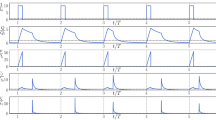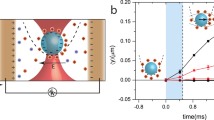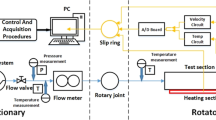Abstract
Electrical and mechanical power, together with other forms of useful work, are generated worldwide at a rate of about 1012 watts, mostly using heat engines. The efficiency of such engines is limited by the laws of thermodynamics and by practical considerations such as the cost of building and operating them. Engines with high efficiency help to conserve fossil fuels and other natural resources, reducing global-warming emissions and pollutants. In practice, the highest efficiencies are obtained only in the most expensive, sophisticated engines, such as the turbines in central utility electrical plants. Here we demonstrate an inexpensive thermoacoustic engine that employs the inherently efficient Stirling cycle1. The design is based on a simple acoustic apparatus with no moving parts. Our first small laboratory prototype, constructed using inexpensive hardware (steel pipes), achieves an efficiency of 0.30, which exceeds the values of 0.10–0.25 attained in other heat engines5,6 with no moving parts. Moreover, the efficiency of our prototype is comparable to that of the common internal combustion engine2 (0.25–0.40) and piston-driven Stirling engines3,4 (0.20–0.38).
This is a preview of subscription content, access via your institution
Access options
Subscribe to this journal
Receive 51 print issues and online access
$199.00 per year
only $3.90 per issue
Buy this article
- Purchase on Springer Link
- Instant access to full article PDF
Prices may be subject to local taxes which are calculated during checkout



Similar content being viewed by others
References
Walker, G. Stirling Engines (Clarendon, Oxford, (1960).
Bejan, A. Advanced Engineering Thermodynamics 2nd edn (Wiley, New York, ( 1997).
Mechanical Technology Inc., Latha, NY Automative Stirling Engine-Mod II Design Report (Tech. Rep. CR-175106, NASA Lewis Research Cente, Cleveland, Ohi, (1986).
Slaby, J. G. in 21st Intersociety Energy Conversion Engineering Conf. Vol. 1 420–429 (Am. Chem. Soc., Washington DC, ( 1996).
Proc. 29th Intersociety Energy Conversion Engineering Conf. (Am. Inst. of Aeronautics and Astronautics, Washington DC, (1994).
Godshalk, K. M.et al . Characterization of 350?Hz thermoacoustic driven orifice pulse tube refrigerator with measurements of the phase of the mass flow and pressure. Adv. Cryogen. Eng. 41, 1411–1418 (1996).
Radebaugh, R. Areview of pulse tube refrigeration, Adv. Cryogen. Eng. 35, 1191–1205 (1990).
Swift, G. W. in Proc. DOE Natural Gas Conf.Paper 7.1 (Federal Energy Technology Center, Morgantown, West Virginia, (1997).
Ceperley, P. H. Apistonless Stirling engine—the traveling wave heat engine. J. Acoust. Soc. Am. 66, 1508–1513 (1979).
Yazaki, T., Iwata, A., Maekawa, T. & Tominaga, A. Traveling wave thermoacoustic engine in a looped tube. Phys. Rev. Lett. 81, 3128–3131 (1998).
Swift, GW. Thermoacoustic engines. J. Acoust. Soc. Am. 84, 1145–1180 (1988).
Ceperley, P. H. Gain and efficiency of a short traveling wave heat engine. J. Acoust. Soc. Am. 77, 1239–1244 ( 1985).
Kinsler, L. E., Frey, A. R., Coppens, A. & Sanders, J. V. Fundamentals of Acoustics (Wiley & Sons, New York, (1982).
Ward, W. C. & Swift, G. W. Design environment for low amplitude thermoacoustic engines (DeltaE). J. Acoust. Soc. Am. 95, 3671–3672 (1994).
Gedeon, D. in Cryocoolers 9 (ed. Ross, R. G.) 385–392 (Plenum, New York, (1997).
Olson, J. R. & Swift, G. W. Acoustic streaming in pulse tube refrigerators: tapered pulse tubes. Cryogenics 37, 769–776 (1997).
Streeter, V. L. Handbook of Fluid Dynamics (McGraw-Hill, New York, ( 1961).
Idelchik, I. E. Handbook of Hydraulic Resistance 3rd edn (CRC Press, Boca Raton, FL, (1994).
Swift, G. W., Gardner, D. L. & Backhaus, S. Acoustic recovery of lost power in pulse tube refrigerators. J. Acoust. Soc. Am. 105, 711– 724 (1999).
Fusco, A. M., Ward, W. C. & Swift, G. W. Two-sensor power measurements in lossy ducts. J. Acoust. Soc. Am. 91, 2229–2235 (1992).
Acknowledgements
We thank D. L. Gardner, C. Espinoza and R. Rockage for their assistance in constructing the engine. This work was supported by the Office of Basic Energy Sciences in the US DOE.
Author information
Authors and Affiliations
Corresponding author
Rights and permissions
About this article
Cite this article
Backhaus, S., Swift, G. A thermoacoustic Stirling heat engine. Nature 399, 335–338 (1999). https://doi.org/10.1038/20624
Received:
Accepted:
Issue Date:
DOI: https://doi.org/10.1038/20624
This article is cited by
-
An Analytical Investigation of a Thermoacoustic stirling Engine
Arabian Journal for Science and Engineering (2024)
-
Frozen sound: An ultra-low frequency and ultra-broadband non-reciprocal acoustic absorber
Nature Communications (2023)
-
Investigation of a two-diaphragm thermoacoustic Stirling engine using passivity method
Journal of the Brazilian Society of Mechanical Sciences and Engineering (2023)
-
Assessment of a diaphragm thermoacoustic Stirling engine using the energy standpoint and genetic algorithm
International Journal of Energy and Environmental Engineering (2023)
-
Thermodynamics-Acoustics Coupling Studies on Self-Excited Combustion Oscillations Maximum Growth Rate
Journal of Thermal Science (2022)
Comments
By submitting a comment you agree to abide by our Terms and Community Guidelines. If you find something abusive or that does not comply with our terms or guidelines please flag it as inappropriate.



